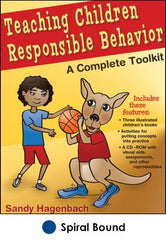Responsible behavior is increasingly taught in schools
This is an excerpt from Teaching Children Responsible Behavior by Sandra Hagenbach.
The job of teaching children responsible behavior is increasingly falling to schools. It doesn't take new teachers long to confront the sad reality that some children enter school without the most basic self-management abilities, and that this has detrimental effects on class environment and learning. As classroom management challenges and character education initiatives abound, the need to effectively teach children essential standards of positive behavior becomes more pressing at all age levels, throughout the curriculum.
Physical education is the perfect setting for teaching social skills. In these classes, children are often free to interact with classmates and are expected to share, take turns, and honestly follow rules. They are put in situations in which teamwork and problem solving are essential for success. Furthermore, physical education has a national standard that specifically addresses responsible personal and social behavior. There is no better laboratory for teaching these life lessons than the gym. Physical educators have the exciting challenge of leading the way in teaching responsible social behavior to children.
My Journey
As a seasoned teacher, I have worked in a variety of settings. I've taught in elementary schools with various combinations of grades (schools with fifth and sixth grade only, kindergarten through fifth grade, and kindergarten and first grade). I taught preschool gymnastics and swimming at a YMCA, and presently I am teaching at a kindergarten through fourth-grade school in De Pere, Wisconsin. I learned early that being organized and prepared with engaging lessons that kept students involved helped minimize behavior problems.
When I switched from teaching kindergarten through fifth grades to just kindergartners and first graders, I became more aware of social situations with the younger students that I wanted to eliminate, such as fighting over the color of a ball. Watching two students partner up and not allow another student to join in would break my heart, knowing my son with autism was most likely the one being left out at his school. Safety concerns also arose. I'd see students run to line up, sliding on their knees in order to be first in line, and I'd wait for an injury or accident to occur. Having students follow rules to behave started to seem shallow. Instead, as both a teacher and a parent, I saw the need to teach social skills, skills built on awareness of and empathy for all.
It was during this time that I attended a session led by educator and author Don Hellison on teaching responsible behavior. Hellison's concept of having students take ownership of their behavior, using an intrinsic approach, made a lot of sense, and his book Teaching Responsibility Through Physical Activity was soon on my shelf. Becoming acquainted with Hellison's levels was the first of the three pivotal moments that helped me create the method of teaching responsible behavior described in this book and CD package.
My second inspiration was the discovery of literature's power in teaching physical education. While teaching in Mundelein, Illinois, my principal observed me doing a movement lesson to the book Where the Wild Things Are by Maurice Sendak. She was amazed to see literature integration in the gym. A short time later I had my review meeting on the lesson. As part of the review process, the principal set a goal for me to incorporate one piece of literature into a lesson once a month. My passion was fired. I loved the opportunity to create engaging lessons that taught skill development, creative movement, or fitness concepts using children's literature as the medium. I longed for children's literature that was written for the gym setting and taught physical education concepts.
The third and most difficult inspiration was my experience with my autistic child. My son Ryan has taught me to be patient, to think on my feet, to differentiate instruction, and to be ready to put out fires and control tantrums. I learned the importance of social stories for helping autistic children learn social skills and preparing them for unknown situations. In a social story, the autistic child is the main character in a narrative that shows him or her making positive social decisions and how the situation will look and feel with the positive outcome plainly stated.
Whether the skill was sharing a seat on the bus or staying close to Mom at the mall, social stories helped Ryan. When Ryan was diagnosed with epilepsy, the road became even rougher, and later, the social stories became more important as I wrote one for him in preparation for his brain surgery.
These three experiences have inspired my teaching of responsible behavior. I have modified Don Hellison's levels to create a structure for teaching responsibility that empowers elementary students to be accountable for their own behavior. My passion for integrating literature into physical education and the power of social stories came together when I wrote the three children's stories that teach social skills in the physical education setting. Hellison's levels and the children's stories form the core of my integrated system for teaching responsible behavior for elementary students.


Get the latest insights with regular newsletters, plus periodic product information and special insider offers.
JOIN NOW


